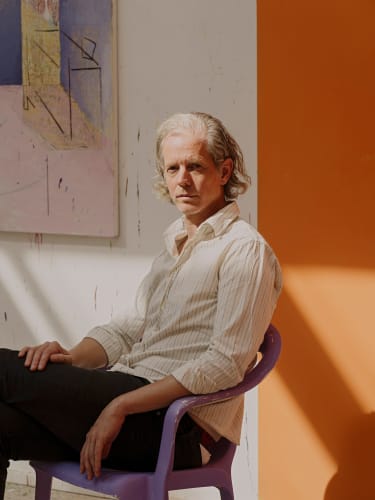Matthias Weischer’s paintings depict domestic interior scenes and landscapes that challenge the viewer’s perception of space. One of the foremost painters of his generation, Weischer has refined his technique by repeatedly crafting and restaging compositions, often drawing from his own studio as a point of departure. He gradually builds thick layers of pigment on the canvas, creating surfaces alive with rich texture. This approach allows for a striking interplay between intricate detail and elusive space. In his recent work, Weischer constructs enigmatic interiors that suggest a fleeting human presence. Each room captures a moment suspended in time; the sparse furniture and signs of disrepair evoke a sense of abandonment. The uncanny atmosphere is heightened by the recurring presence of paintings within the depicted spaces, resulting in a disorienting layering of dimensions.
Matthias Weischer (b.1973 in Elte, DE) lives and works in Leipzig (DE). He studied at the Leipzig Academy, where he received his Bachelor’s degree in 2000 and his Master’s degree in 2003. In 2004, Weischer was chosen as the protégé of the British artist David Hockney through the Rolex Mentor & Protégé Arts Initiative. In 2005 Weischer participated in the Prague Biennial 2 (CZ) and the 51st Venice Biennial (IT).
Recent exhibitions include Off Target, GRIMM, London (UK), 2025; How To Look At..., HALLE 14, Leipzig (DE), 2025; 10 Years G2 Kunsthalle, G2 Kunsthalle, Leipzig (DE), 2025; OUR HOUSE, Museum Giersch of the Goethe, University, Frankfurt am Main (DE), 2024; Matthias Weischer, with Wolfram Ebersbach, Marburger Kunstverein, Marburg (DE), 2024; Arcadia, Kewenig Gallery, Berlin (DE), 2024; Licked by the Waves | New Bathers in Art, Museum MORE, Gorssel (NL), 2024; True Colors, AkzoNobel Art Foundation at the Kunstmuseum den Haag (NL), 2024; Sequence, GRIMM, New York, NY (US), 2023; STANZE, Fondazione Coppola, Vicenza (IT), 2023; and Wo Man Sich Trifft / Where We Meet, curated by Juriaan Benschop, Emsdettener Kunstverein (DE), 2023.
Selected collections include AkzoNobel Art Foundation, Amsterdam (NL); AmC Collezione Coppola, Vicenza (IT); Arken Museum of Modern Art, Arken (DK); Drents Museum, Assen (NL); Essl Museum – Kunst der Gegenwart, Klosterneuburg (AT); Fundació Sorigué, Lleida (ES); G2 Kunsthalle, Leipzig (DE); Kunstmuseum, The Hague (NL); MdbK | Museum der bildenden Künste, Leipzig (DE); Museum of Contemporary Art, Los Angeles, CA (US); Museum für Moderne Kunst (MMK), Frankfurt am Main (DE); Pinault Collection, Paris (FR); Rubell Museum, Miami, FL and Washington DC (US); Sammlung Goetz, München (DE); Scharpff Collection, Bonn (DE); SØR Rusche Sammlung Oelde/Berlin, Oelde-Stromberg (DE); Telegraph Foundation, Olomouc (CZ); Museum Voorlinden, Wassenaar (NL); Weserburg | Museum für moderne Kunst, Bremen (DE) and Zabludowicz Collection, London (UK).
